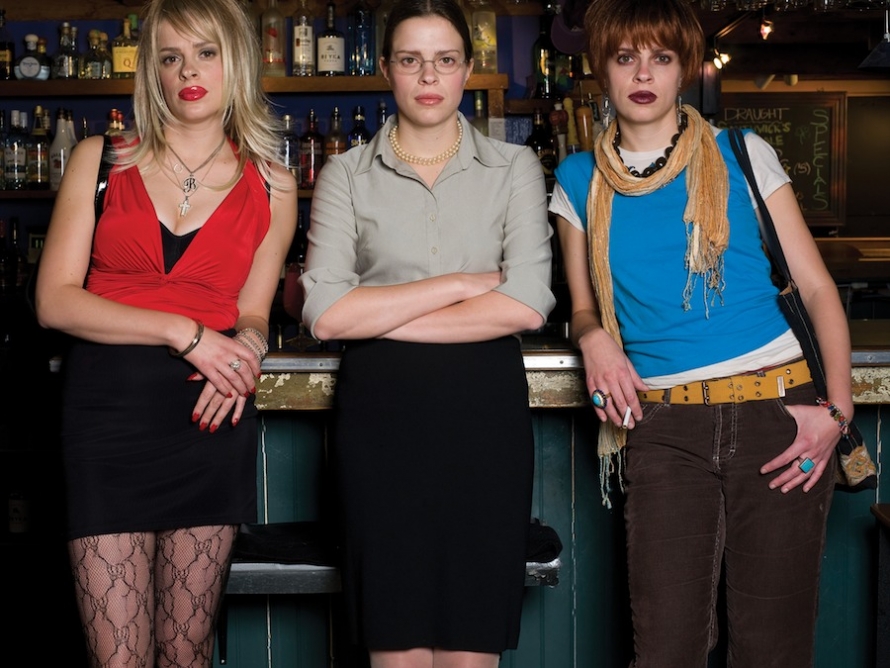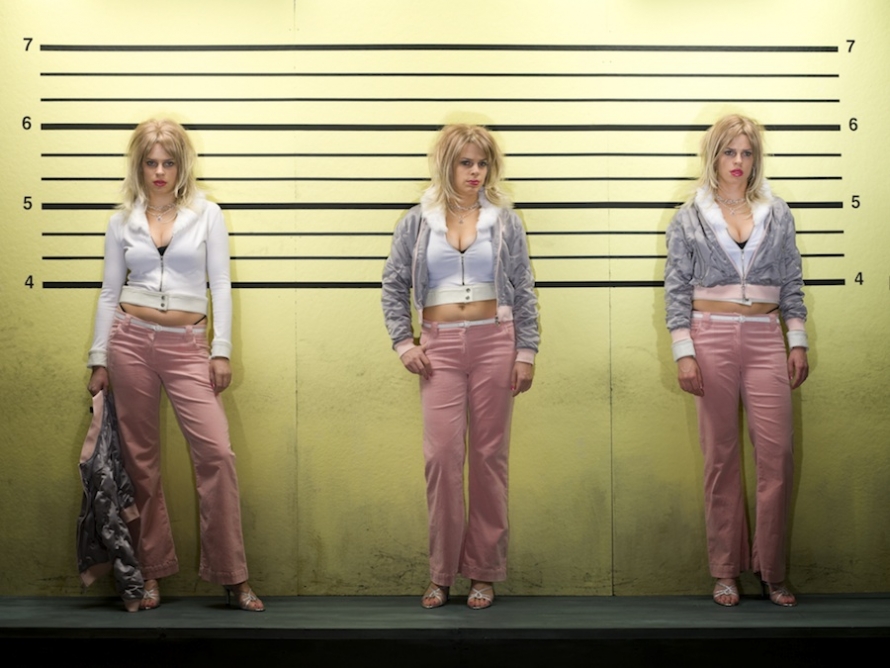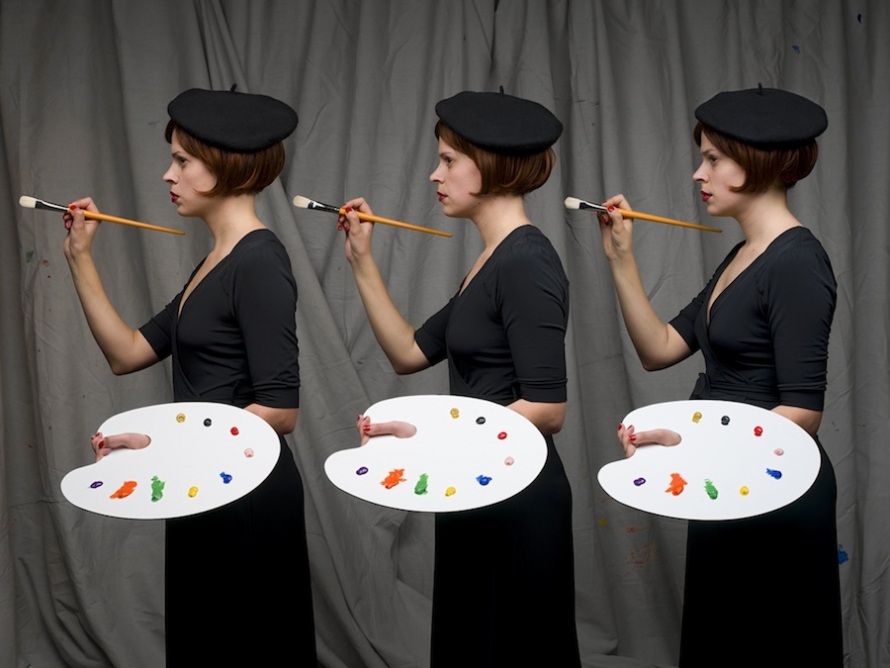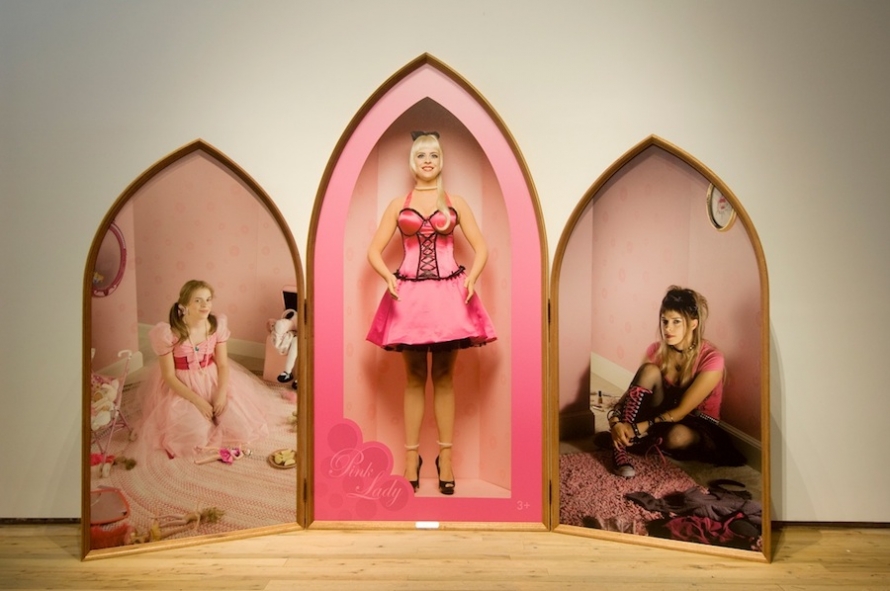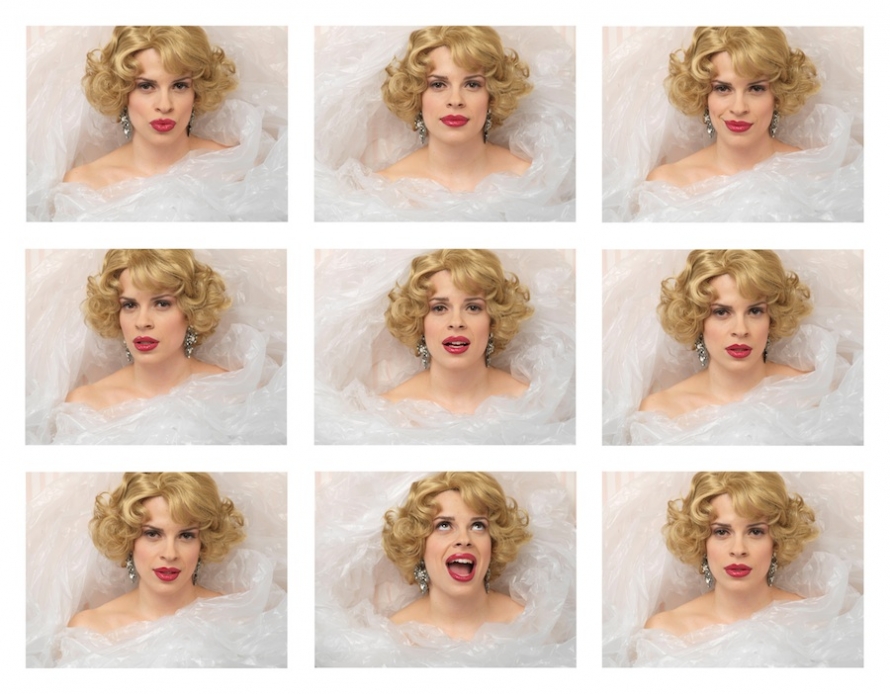The subjects of TRIIIBE’s remarkable photos are the Casilio triplets, whose costume changes and settings are chameleon-like and socially thought-provoking. If four minds—the triplets’ and their photographer’s—are better than one, how does that process change with the help of many friends enlisted for their photoshoots?
TRIIIBE is a collective composed of photographer Cary Wolinsky, triplets Alicia, Kelly, and Sara Casilio, and their collaborators. The Casilio triplets received their BFA from Massachusetts College of Art, where they received the Steven Paine Scholorship and the Crosby Sculpture Award. Wolinsky is a photographer who shot for National Geographic, co-founded Picture Network and the Center for Digital Imaging Arts at Boston University, has been published widely, and is in the collection of the Museum of Fine Arts, Boston, DeCordova Museum, Fogg Art Museum, Tikotin Museum Haifa, Harvard University, and the Cleveland Art Museum. In 2009, TRIIIBE had their first solo exhibition of photographs at Gallery Kayafas. They unveiled a solo exhibition in Boston University’s 11,000-square-foot gallery 808 in the fall of 2010. Their show at DODGEgallery is TRIIIBE’s New York debut.
TRIIIBE is on view at DODGEgallery through Feb. 13, 2011. Images courtesy DODGEgallery, New York.
How did you come together as TRIIIBE?
Alicia: Well, we three all found each other. We didn’t go out looking for Cary—he found us first. We were at a professor of ours’ retirement party, and two of us came to the party dressed as the professor, who’s got a white beard and a belly, and wears the same overalls every day. Cary was at the party because he was the neighbor of our professor. He was just finishing at National Geographic and wanted to work on something new, so he got in contact with our professor, who said, “Oh, there are actually three of them!” We met, had dinner, and we all wanted to start working together. The three of us were doing performances and had started thinking of some still shots of ourselves, but we had no idea what photography was really about until we met Cary.
What is it about triplets that gets to people?
Sara: Maybe we should ask you that! [laughter]
Kelly: I can only guess what intrigues people about triplets, but what I think it is, is that people think that we think the same, or that we always agree with each other, all one big happy family. Since they think that we think the same, dressing in different ways defeats in their heads of what triplets should be.
Cary: I think of the question in two parts. The first part is, “Why are triplets and multiples so intriguing to people?” and the second part is “How does that get leveraged into your art form?” The first part of that is…I don’t know. But I do know that for 35 years I worked for National Geographic, and when I’d go to dinner parties all people would want to know is what it’s like to be a National Geographic photographer, and where have I been, and blah blah blah. Now that people know I work with TRIIIBE, the only thing anyone ever wants to know about is “What’s it like working with triplets?” That’s all they care about! There’s an intrigue that’s so deep, so fascinating, and so real, and I think one of the reasons that I was attracted to them right at the beginning is that as a little boy, my best friends were twins. And I noticed that this phenomenon right through my childhood: I was always walking around with these celebrities. Why they were celebrities? I don’t know! Just that people thought that since they were twins, somehow that made them special. And it did! It affected them and their behavior and gave, them to my mind, a magical power. So the first part of your question, I don’t have an answer to, but I agree with you: People are incredibly intrigued with multiples. The second part of your question: If you observe the way people observe multiples, and the assumptions they make about them, that somehow they’re identical in every aspect of their lives—which is just absurd—then you can use that with a kind of tongue-in-cheek effect in your art. I think that is the essence of what we do. We start with that simple idea that people are intrigued with triplets, we play with that idea and the assumptions that people make, and it turns out to be an incredibly powerful force.
Sara: I feel like our culture is so much about the way that we look. Everybody is so used to having their own individual identity, looking different from other people, that just the very notion of having identical people seems to disrupt that.
Alicia: But at the same time, I think that somehow we represent this relationship with one another that everybody else yearns to have, this deep understanding of one another. So people look at us and see that, but they don’t know that we argue just as much as any other sisters! Seeing that, it challenges them and their own relationships.
Is TRIIIBE just the four of you?
Alicia: The four of us, and then we have a lot of collaborators who work with us as regularly as the four of us—we could rattle off plenty, but we are the main ones.
Cary: We think of ourselves as the founders, and TRIIIBE expands and contracts for every project. Sometimes we’re many people—the show we just did in Boston required the help of many artists and artisans. At that moment, we considered them all TRIIIBE.
What is the brainstorming process like?
Sara: It changes. Sometimes it would be a visual that popped into Cary’s head, and we would start working from there, and sometimes it starts with a concept from us. But it’s always a collaboration once we start from that point. It’s like Cary might have this image in his head, but when we all start to bounce ideas off of it, how we see this form take shape all goes back and forth. We navigate it together, it’s organic.
Kelly: For the show we did at B.U., the way the idea started was with the space we had. The space is an old Cadillac dealership, but it also looks really religious. So Alicia, Sara, and Marie Brown (our collaborator on this project) all came together and started coming up with ideas—triptychs, then we wanted to play off the story of Adam and Eve, and we wanted to play off apples. Then once that was all brought to Cary, he sat and sketched up ideas for all these triptychs. Then we picked from his ideas, applied apples, and worked from there.
Alicia: And then from there everything changes after that, too—we start working with costume designers, and all these other people who really contribute in different ways to shape the whole piece.
Sara: Everybody is essential to the making of the work. We don’t direct the costume designer or the makeup artist—I mean, we give them a feel for what we want, but they definitely bring their own voice to it. It’s very much that we’re all artists and we all collaborate with each other.
What do you call yourselves? Artists, sculptors, photographers…
Kelly: We hate labeling ourselves! I think artist is the simplest thing. We all work on other projects of our own, so I like to think of myself as someone who’s creative, that’s all.
Cary: When we first came together, the four of us, there was some thinking that they were performance artists and I was a photographer, and that somehow I would record what they did. As it turns out, I think it’s their range of capabilities that makes this a unique collaboration. A photograph is not only a photograph, it’s an installation, it’s costume design, it’s theater. So what do you call that? It’s like saying, what does a rock band do? They write music, they produce music, they do all these things. So what we have come to do without plan and without purpose is to say, “What do we need to do to achieve the vision we have in mind? Oh, we need to do all these things? Well, what skills do we have amongst us?” And it turns out, we have an astonishing variety of skills, and for what we don’t have, we go looking for people to help us, which turns out to be another layer of excitement. So if you think of it more as an orchestra or a theater company or movie-making, where a lot of people come together to make something, and on top of that that the collaborative vision—it doesn’t really matter who starts with the first idea. Inevitably, I can’t think of a single project we’ve done together that ended up looking exactly the way that whoever thought of it first thought it would look.
Describe a photoshoot.
Kelly: We usually have a makeup person who does our hair and sometimes brings in props. There are the three of us and Cary. Then we have a spotter who looks to make sure that everything is in place and gives suggestions on composition, etc. Then there’s someone helping with the lighting, helping with backing up files. Sometimes we have a friend who’s just in to be general help. And for the last number of photoshoots we just had more people in the room to make sure things are going smoothly. Adjusting the set, whatever it is that needs to get done.
Alicia: At one point in the last seven shots we did for the triptychs, we had 10 people in the room all working on various things. Props being constructed at the last minute, lighting being set up, organizing the files, spotters, us getting in costume—it can be quite hectic sometimes, but it’s really fun.
What are you working on now?
Cary: We’ve had an incredible year: Inside of one year we had three exhibitions. This is the first breathing moment we’ve had. So this week we’re going to be meeting for the first time since the show opened in New York and one of the big items on the agenda will be, “OK guys, what’s next?”
